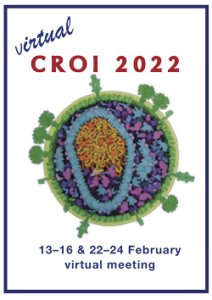CROI 2022: Islatravir studies for HIV treatment and PrEP
1 April 2022. Related: Conference reports, Antiretrovirals, CROI 29 (Retrovirus) 2022.
Kirk Taylor, HIV i-Base
 CROI 2022 included several studies showing the strengths of islatravir for both treatment and prevention, even though this pipeline compound is currently on hold (see comments below). [1]
CROI 2022 included several studies showing the strengths of islatravir for both treatment and prevention, even though this pipeline compound is currently on hold (see comments below). [1]
Results from a phase 2 pharmacokinetic (PK) study reported stable plasma and tissue concentrations of islatravir at week 24 on a monthly dosing regimen, that was similar in plasma, vaginal and rectal tissue. [2]
And a separate poster on penile tissue (often not studied) also supported monthly oral dosing. [3]
Two safety studies reported no significant effects of islatravir upon bone mineral density, renal function, weight gain or QTc. [4, 5]
Stable PK for monthly dosing of islatravir at 6 months
A phase 2a placebo-controlled sub-study in HIV negative adults tracked the PK profile of oral islatravir. [3] PK data were calculated for mucosal tissues (cervical, vaginal and rectal), rectal cells and PBMCs.
Participants were female (39%), predominantly Black or African American (70%), median age was 34 years (SD: 11), and were randomised to islatravir (60 mg QM or 120 mg QM) or matching placebo.
Islatravir concentrations peaked at week 1 before dropping to a steady state by week 4 that was then maintained through week 24. Comparable PK profiles were reported for all tissues and cell types tested. The peak and steady state values were higher for the 120 mg group but followed the same trend as the 60 mg group.
Islatravir levels remained above the PBMC PK threshold at each timepoint.
Similar tissue distribution profiles were observed in males and females and islatravir was detected in rectal and vaginal tissues.
Islatravir protects against penile HIV transmission in mice
A mouse study reports tissue distribution and efficacy of daily islatravir (1.8 mg/mL) as PrEP in a penile HIV challenge model. [3]
HIV positive humanised mice responded to islatravir with rapidly declining viral RNA in peripheral blood and penile tissues.
The islatravir group had higher CD4 counts than control animals in peripheral blood and penile tissues.
Islatravir was administered as PrEP and penile HIV challenge performed on three occasions. Whilst 6/11 untreated mice had detectable viremia, all mice in the islatravir group were protected from HIV transmission up to four weeks post-challenge (p=0.0238).
Islatravir does not affect BMD, renal function or QTc interval
The metabolic and renal profile of islatravir was assessed in a phase 2a placebo-controlled trial. [4] Participants were recruited from USA, Israel and South Africa, female (67%), Black (42%), white (53%), Hispanic/Latinx (15%) and median age was 31 (IQR: 18 to 58). Participants received once-monthly islatravir (either 60 mg, n=97 or 120 mg, n=97) or placebo (n=48).
Baseline renal function and median weights were comparable across groups. No significant changes were observed at week 24.
Median weight gain at week 24 was 1.8% for the 120 mg QM islatravir group, which translated to small rises in peripheral (2.5%) and trunk (3.4%) fat. No differences were observed between placebo and the 60mg QM islatravir groups.
A further study evaluated QTc following single dose of islatravir (0.75 mg or 240 mg) or moxifloxacin. [5]
Participants were randomised to islatravir (n=28), moxifloxacin (n=7) or placebo (n=7). Participant characteristics were female (76%), white (89%), Hispanic/Latinx (78%) and median age was 41 (IQR: 19-64).
A transient QTc rise was observed for the 240 mg islatravir group. This effect started after one hour and returned to baseline by hour 4. The rise did not exceed 10 ms and was smaller than the effect of moxifloxacin, which is known to prolong QTc.
comment
These studies highlight the stable PK profile of islatravir, consistency in different tissue types (allowing similar dosing irrespective of gender and biological risk) and promising evidence for its efficacy as PrEP.
It shows good renal, metabolic and cardiac safety profiles in HIV negative people.
However, the underlying mechanism of lowered CD4 counts in HIV positive people enrolled on islatravir trials has yet to be explained and is sufficiently serious for most studies to be on clinical hold.
Long-term safety data, including the potential for reversibility, are likely to be and FDA requirement to restart studies, which could easily take longer than a year to establish.
The high demand for the range of long-acting formulations means that the development of islatravir is not likely to be easily dropped.
References
Unless stated otherwise, references are to the 29th Conference on Retroviruses and Opportunistic Infections, 12–16 and 22–24 February 2022, virtual meeting. Depending on CROI policy, links might require conference registration and might only be active for a limited time on this platform after the meeting.
- Collins S. FDA further limit use of islatravir in ongoing studies. HTB (17 December 2022).
https://i-base.info/htb/41866 - Hendrix CW et al. Islatravir distributiona in mucosal tissues, PBMC & plasma after monthly oral dosing. CROI 2022. 12-16 February 2022, virtual. Oral presentation 83.
https://www.croiconference.org/abstract/islatravir-distribution-in-mucosal-tissues-pbmc-plasma-after-monthly-oral-dosing/ - Kovarova M et al. EFda Offers complete protection from repeated penile HIV challenges. CROI 2022. 12-16 February 2022, virtual. Poster 210
https://www.croiconference.org/abstract/efda-offers-complete-protection-from-repeated-penile-hiv-challenges/ - Macdonald P et al. Phase 2a trial of islatravir once monthly for HIV PrEP: Week 24 metabolic and renal outcomes. CROI 2022. 12-16 February 2022, virtual. Oral presentation 85.
https://www.croiconference.org/abstract/phase-iia-trial-of-islatravir-qm-for-hiv-prep-week-24-metabolic-and-renal-outcomes/ - Matthews RP et al. Islatravir does not prolong QTc in a thorough QT study in healthy participants. CROI 2022. 12-16 February 2022, virtual. Poster 432.
https://www.croiconference.org/abstract/islatravir-does-not-prolong-qtc-in-a-thorough-qt-study-in-healthy-participants/ (abstract)
https://ww2.aievolution.com/cro2201/index.cfm?do=abs.viewAbs&abs=2988 (original abstract)
This report was first published online on 3 March 2022.

